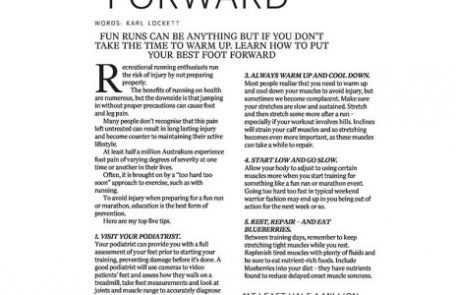Best Foot Forward
FUN RUNS CAN BE ANYTHING BUT IF YOU DON’T TAKE THE TIME TO WARM UP. LEARN HOW TO PUT YOUR BEST FOOT FORWARD
Recreational running enthusiasts run the risk of injury by not preparing properly. The benefits of running on health are numerous, but the downside is that jumping in without proper precautions can cause foot and leg pain.
Many people don’t recognise that this pain left untreated can result in long lasting injury and become counter to maintaining their active lifestyle.
At least half a million Australians experience foot pain of varying degrees of severity at one time or another in their lives.
Often, it is brought on by a “too hard too soon” approach to exercise, such as with running.
To avoid injury when preparing for a fun run or marathon, education is the best form of prevention.
Here are my top five tips.
1. VISIT YOUR PODIATRIST.
Your podiatrist can provide you with a full assessment of your feet prior to starting your training, preventing damage before it’s done. A good podiatrist will use cameras to video patients’ feet and assess how they walk on a treadmill, take foot measurements and look at joints and muscle range to accurately diagnose any existing or potential foot issues, taking into account their lifestyle and exercise regime.
2. MAKE SURE THE SHOE FITS.
Once you’ve visited the podiatrist, you will know about your individual foot structure, such as
how flat your feet are, and pronation (how much you roll inwards). Your foot type will determine the type of running shoes you need and in particular how much support and control you need in certain areas. If necessary, use shoe inserts fitted by your podiatrist to support your arches.
3. Always warm up and cool down
Most people realise that you need to warm up and cool down your muscles to avoid injury, but sometimes we become complacent. Make sure your stretches are slow and sustained. Stretch and then stretch some more after a run – especially if your workout involves hills. Inclines will strain your calf muscles and so stretching becomes even more important, as these muscles can take a while to repair.
4. START LOW AND GO SLOW.
Allow your body to adjust to using certain muscles more when you start training for something like a fun run or marathon event. Going too hard too fast in typical weekend warrior fashion may end up in you being out of action for the next week or so.
5. REST, REPAIR – AND EAT BLUEBERRIES.
Between training days, remember to keep stretching tight muscles while you rest. Replenish tired muscles with plenty of fluids and be sure to eat nutrient-rich foods. Include blueberries into your diet – they have nutrients found to reduce delayed onset muscle soreness.
Written by Karl Lockett

